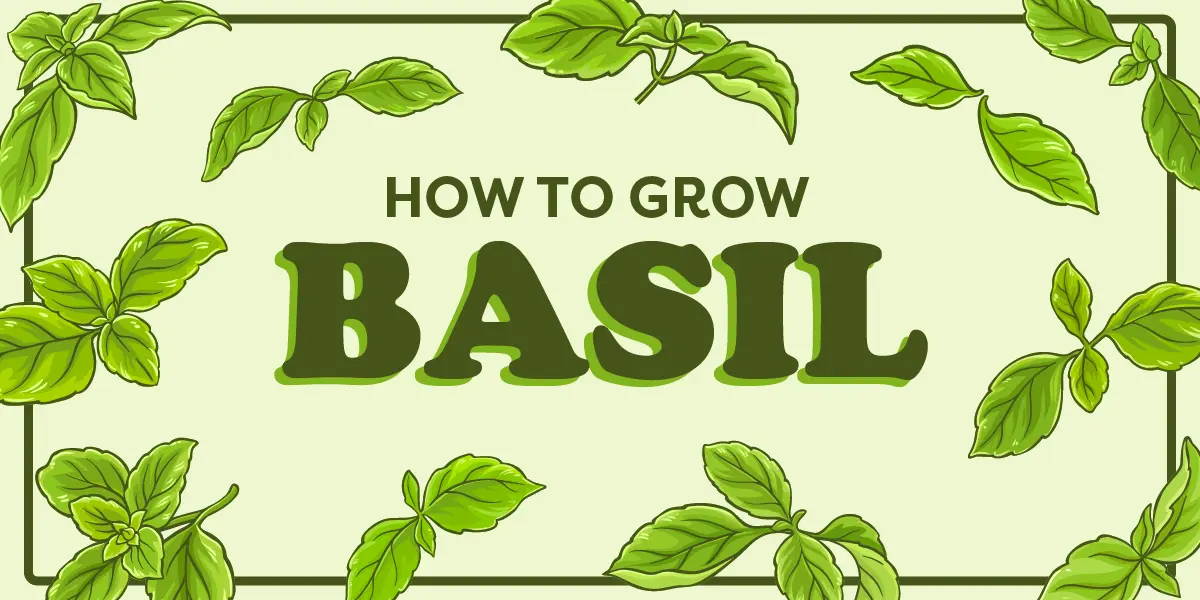If top chefs ever put it to a vote, basil would be numero uno in the kitchen, captain of the Herb Team, and Most Likely to Succeed (or end up in sauce).
It’s easy to see why.
This aromatic herb can bring a dish to life with a fresh, savory sweetness, from Italian pasta to Thai salads. It’s easy to cultivate, fast to grow, and ready to harvest within weeks of planting. Best of all, you can grow it year-round indoors in very little space.
Origins of Basil
Basil is native to tropical regions from Central Africa to Southeast Asia. The plant has been cultivated for over 5,000 years and is revered in various cultures for its medicinal properties and aromatic flavors.
Basil made its way to Southern Europe around 2,000 years ago, primarily through trade routes from the East. Roman explorers and traders played a significant role in the spread of basil, as they brought back seeds and plants during their expeditions.
The herb thrived in the region’s warm, sunny climate and quickly gained popularity in Mediterranean cuisine.
European settlers introduced basil to America during the age of exploration and colonization. Early colonists planted it in their gardens, not only for its culinary versatility but also for its therapeutic properties.
Over time, the herb became a fixture in American kitchens, particularly in regions with Italian and Mediterranean populations.
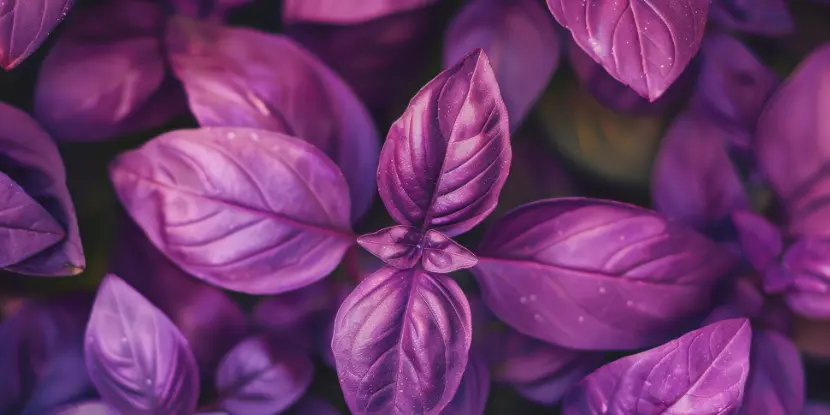
The striking foliage of the purple basil plant.
Choosing Your Basil Variety
Did you think there was only one? Think again!
- Sweet Basil is the most common and popular type of basil. Its large, shiny leaves have a sweet and slightly spicy flavor, making it a perfect complement for pesto and other Italian dishes.
- Thai Basil has a distinct anise-like flavor and smaller, pointed leaves.
- Lemon Basil has a citrusy aroma and taste, giving a fresh twist to any dish.
- Purple Basil has a captivating deep purple color and a slightly stronger flavor than sweet basil.
Growing Basil Indoors
Materials Needed
- A pot or container with drainage holes
- Potting soil
- Basil seeds or seedlings
- Watering can
- Fertilizer (optional)
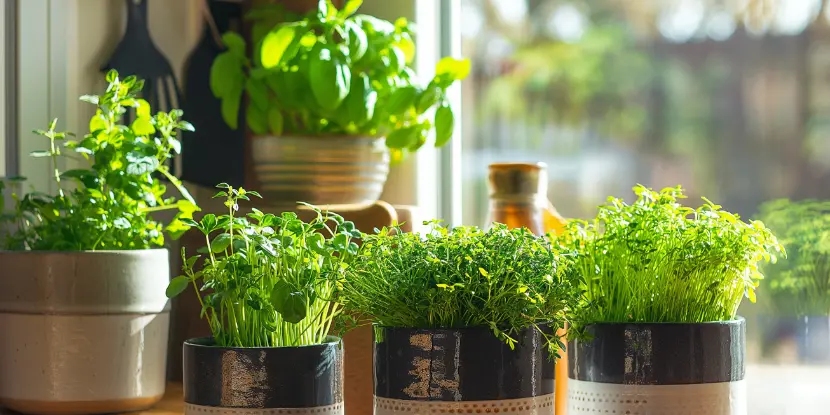
An indoor herb garden placed near a window.
Another approach is to grow basil hydroponically. Many indoor gardeners prefer this method because it’s less messy, takes up less space, and offers precise control over growing conditions. You’ll need:
- A hydroponic system (such as the Kratky method)
- Net cups or a growing medium
- Nutrient solution
- Basil seeds or seedlings
Planting & Caring for Basil
- Choose a sunny spot. Basil loves sunlight, so place your pot in an area with at least six hours of direct sunlight daily. If using artificial lighting, keep it on for 14–16 hours daily.
- Plant your basil. Fill your pot with potting soil (pH 6.0-7.0) and plant your seeds or seedlings about 1/4 inch deep. Cover them lightly with soil and pat down gently.
- Protect your plant from heat and drafts. Basil thrives in warm conditions but can wilt or dry out if it gets too hot. Keep your plant away from heat sources and drafts.
- Water regularly. Basil needs moist soil, so water it whenever the top inch of soil feels dry. Be careful not to overwater, as this can cause root rot.
- Fertilize (optional). If you’re growing in potting soil, you may want to fertilize once every two weeks. Use a balanced fertilizer diluted according to package instructions.
- Harvest often! Pinch off leaves as needed throughout the plant’s growth cycle to encourage new growth and prevent flowering.
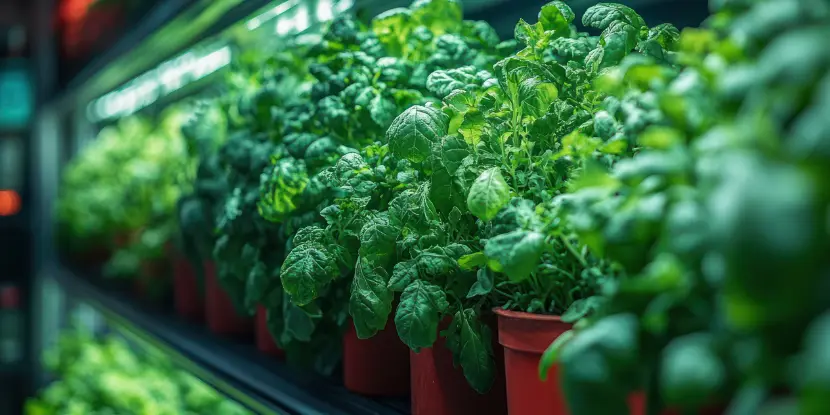
Herbs grow indoors on shelves equipped with artificial lighting.
Propagating Basil
- Stem Cuttings: Propagate basil easily from stem cuttings. Cut a 4-inch section below a leaf node, remove the bottom leaves, and place in water until roots form.
- Transplanting: Once roots are established, transplant the cuttings into a pot with fresh soil.
- Timing: Propagate during the growing season (late spring to early autumn) for best results.
Growing Basil Hydroponically
- Hydroponic Systems: Basil grows well in hydroponic setups. Use a system like Deep Water Culture (DWC) or the Nutrient Film Technique (NFT) for best results.
- Nutrient Solution: Provide a balanced hydroponic nutrient solution designed for herbs.
- Maintenance: Regularly check pH and nutrient levels to ensure healthy growth.
Troubleshooting Common Problems
- Wilting or drooping leaves indicate underwatering or overwatering. Check the soil moisture and adjust accordingly.
- Yellowing leaves may be a sign of nutrient deficiency. Consider fertilizing or switching to a hydroponic setup with balanced nutrients.
- Pests, such as aphids or whiteflies, can be removed by hand or treated with insecticidal soap.
- Stunted growth can occur due to poor lighting or compacted soil. Ensure your basil receives adequate sunlight or grow light exposure, and occasionally loosen the soil to enhance root access.
- Brown leaf spots could be a sign of bacterial or fungal infection. Remove affected leaves and ensure your basil is planted in well-draining soil with proper spacing between plants to prevent spread.
Pruning Basil
- Regular pruning encourages bushier growth. To stimulate new growth, pinch off the top leaves just above a pair of leaves.
- Remove flower buds to prolong the plant’s productive lifespan and enhance flavor.
- Prune every few weeks during the growing season for continuous harvest.
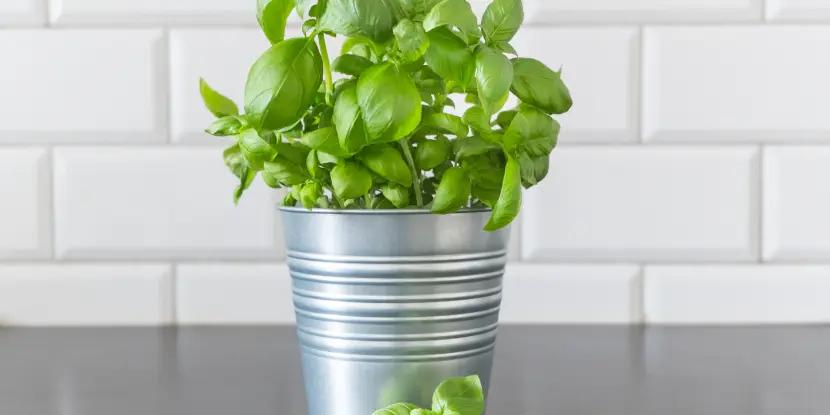
Basil growing indoors in a tin pot.
Harvesting Basil
- Harvest basil leaves once the plant is 6–8 inches tall. Pick the largest leaves first, working your way down the plant.
- Harvest in the morning for the best flavor and aroma.
- Store harvested basil in a glass of water on the counter for immediate use, or freeze it for longer storage.
How to Dry Basil
- Air Drying: Bundle stems and hang them upside down in a warm, dry place. Ensure good air circulation to prevent mold.
- Oven Drying: Spread leaves on a baking sheet and dry in the oven at the lowest temperature setting for several hours.
- Storage: Store dried basil in an airtight container away from direct sunlight.
Favorite Recipes with Basil
Basil Tomato Soup
Ingredients
- Fresh basil leaves
- Tomatoes
- Garlic
- Onion
- Vegetable broth
Instructions
- Sauté garlic and onion until softened.
- Add chopped tomatoes and broth.
- Simmer for 20 minutes, then blend until smooth.
- Stir in fresh basil and serve hot.
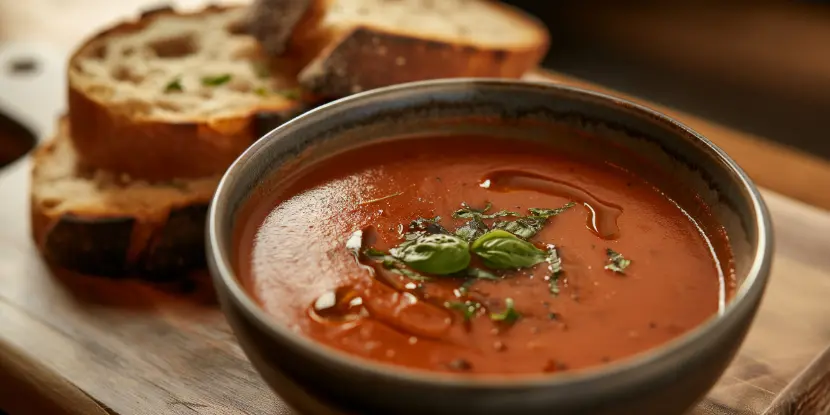
Tomato basil soup is a hearty and easy-to-make winter meal.
Pesto with Olive Oil
Ingredients
- Fresh basil leaves
- Olive oil
- Pine nuts
- Parmesan cheese
- Garlic
Instructions
- Blend basil, garlic, and pine nuts until smooth.
- Add Parmesan cheese and blend again.
- Gradually add olive oil while blending until the desired consistency is reached.
- Season with salt and pepper to taste.
Caprese Salad
Ingredients
- Fresh basil leaves
- Fresh mozzarella cheese
- Tomatoes
- Olive oil
- Balsamic vinegar
- Salt and pepper
Instructions
- Slice the tomatoes and mozzarella cheese into thick rounds.
- Arrange them on a platter, alternating between a slice of tomato, a slice of mozzarella, and a fresh basil leaf.
- Drizzle with olive oil and a splash of balsamic vinegar.
- Season with salt and pepper to taste before serving.
Basil Infused Lemonade
Ingredients
- Fresh basil leaves
- Lemons
- Sugar
- Water
- Ice
Instructions
- In a saucepan, combine sugar and water to make a simple syrup, heating until the sugar dissolves.
- Add a handful of basil leaves to the syrup and let it cool for a few minutes to infuse the flavor.
- Juice the lemons and combine them with the basil-infused syrup in a pitcher.
- Add cold water and mix well over ice.
- Garnish with additional basil leaves and lemon slices before serving.
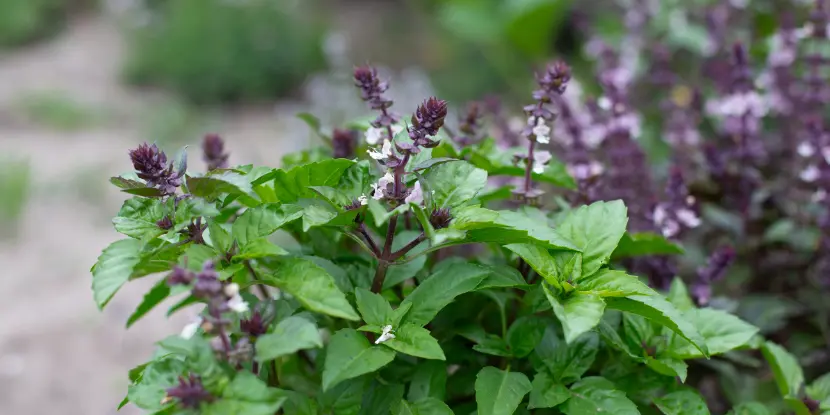
A flowering basil plant.
FAQs: Growing Basil Indoors
Q: How often should I water my indoor basil plant?
Water when the top inch of soil feels dry. Avoid overwatering to prevent root rot.
Q: Can I grow basil from seeds indoors?
Yes, you can start basil seeds indoors. Plant seeds in small pots, keep the soil moist and provide plenty of light.
Q: How long does basil take to grow?
Basil typically takes 3–4 weeks to mature from seedling to harvest-ready plant.
Q: What is the ideal temperature for growing basil indoors?
Basil prefers temperatures between 70 and 85°F (21 and 29°C). Avoid exposing basil to temperatures below 50°F (10°C), which can damage the plants.
Q: Does basil need direct sunlight indoors?
Yes, basil prefers direct sunlight and requires at least 6–8 hours of light daily. If natural light is insufficient, consider using a full-spectrum grow light.
Q: Can I use basil leaves that have flowered?
While basil leaves remain edible after flowering, they may become slightly bitter. For optimal flavor, it’s best to use younger, pre-flowering leaves.
Q: How can I prevent my indoor basil from becoming leggy?
Ensure the plant receives adequate light and regularly prune it by pinching off the top couple of inches every few weeks to encourage bushier growth.

